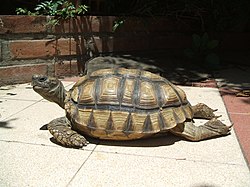| Chaco tortoise | |
|---|---|
 | |
| Chelonoidis chilensis | |
| Scientific classification | |
| Kingdom: | Animalia |
| Phylum: | Chordata |
| Class: | Reptilia |
| Order: | Testudines |
| Suborder: | Cryptodira |
| Family: | Testudinidae |
| Genus: | Chelonoidis |
| Species: | C. chilensis |
| Binomial name | |
| Chelonoidis chilensis (Gray, 1870) | |
| Synonyms [2] | |
| |
The Chaco tortoise (Chelonoidis chilensis), also known commonly as the Argentine tortoise, the Patagonian tortoise, or the southern wood tortoise, is a species of tortoise in the family Testudinidae. The species is endemic to South America.

